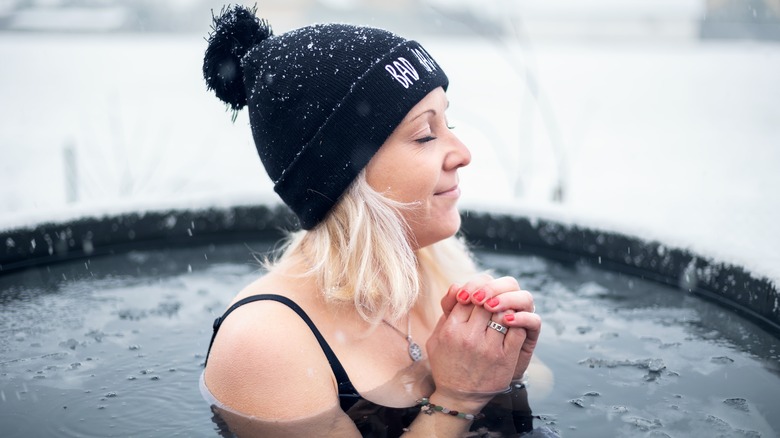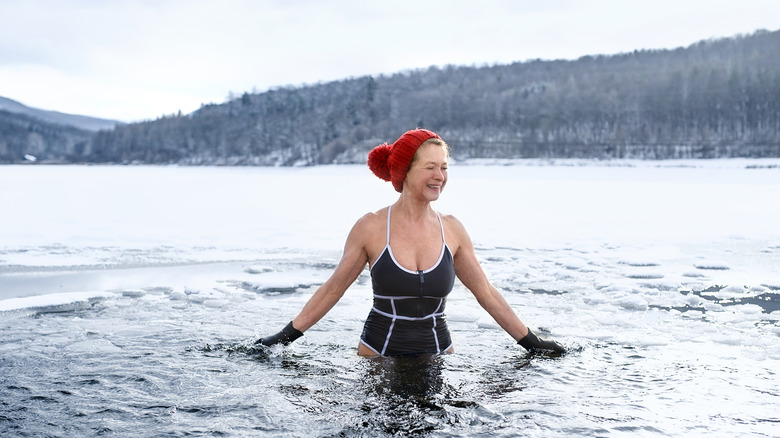Can Cold Water Therapy Actually Help You Lose Weight?
Wellness centers from all over the world are now offering cold water therapy, a form of cryotherapy. Proponents say it boosts metabolism and speeds up post-workout recovery while improving immunity. Most claims are backed up by science, so you might want to consider taking a cold plunge every day. "Cold showers are a convenient way for a weekend warrior, amateur athlete, or anyone who enjoys exercise to get some of the benefits of cold therapy after a workout," notes Sharon Hame, an orthopedic surgeon at UCLA Health. There's also some evidence that cold water therapy can increase calorie burn, leading to fat loss.
According to UCLA Health, this practice may relieve pain, reduce inflammation, and boost circulation. "It works by decreasing how quickly the pain sensation travels through your nerves," explains Dr. Hame. Given these aspects, it's no surprise that cold therapy can also soothe sore muscles, allowing you to work out harder for longer. Some studies also suggest that it may lower the stress response, improve brain function, and protect against heart disease, according to 2022 research published in the International Journal of Circumpolar Health.
As the scientists note, cold water therapy can help with weight loss, too. Not only does it increase resting metabolism, but it also promotes the browning of white adipose tissue, which may reduce obesity risk.
Cold water immersion could be a game changer for weight loss
There's no doubt that cold showers can change your life. This practice, or any form of cold water therapy for that matter, has beneficial effects on metabolism, cardiovascular function, and mental health. According to a 2000 study, immersing yourself in cold water could increase your metabolism by a staggering 350%, reports the European Journal of Applied Physiology. When exposed to cold temperatures, your body burns more calories in an attempt to warm up. Therefore, regular ice baths and cold showers can lead to fat loss.
Cold water immersion also stimulates brown fat (BAT) activity, notes the International Journal of Circumpolar Health. This type of adipose tissue regulates body temperature and increases calorie burn, which may help prevent obesity. In a 2012 study, men exposed to cold temperatures for three hours burned an extra 250 calories through BAT alone, according to the Journal of Clinical Investigation. Another study found that our stem cells start producing brown fat in response to cold temperatures, as reported in the March 2018 edition of Scientific Reports.
But that's not all. As it turns out, cold water therapy may also prevent obesity‐related conditions, according to the International Journal of Circumpolar Health. Over time, this practice can decrease insulin resistance, leading to a lower risk of diabetes and other cardiometabolic illnesses.
How to get started with cold water therapy
Cold therapy has some pretty amazing benefits, but this doesn't mean you should jump into ice-cold water right away. "That cold shock can be dangerous," cardiologist Jorge Plutzky told the American Heart Association (AHA). He also says you shouldn't try it if you have cardiovascular problems or take medications that lower blood pressure or heart rate. As discussed earlier, cold water therapy may protect against heart disease, but most studies were conducted on healthy people. Therefore, it's best to get your doctor's approval before starting out.
If everything looks good, begin by gradually exposing your body to cold temperatures. "Put cold water on the back of your neck. Prime your neurological system that a cold shock is coming," suggests Lee Hill, an exercise scientist interviewed by the AHA. Another piece of advice comes from Dr. Hame, who recommends starting with 30-second cold showers and working your way up to three minutes. Later, you can begin to experiment with whole-body cryotherapy or ice baths.
Ideally, keep the water temperature below 60 degrees Fahrenheit. Immerse yourself slowly, especially during the first minute. Put on some warm clothes as soon as you get out of the water, drink a cup of peppermint tea or other hot beverages, and give your body time to return to normal. As far as frequency goes, it's okay to take ice baths daily to recover faster from training or up to three times per week for a metabolism boost.

